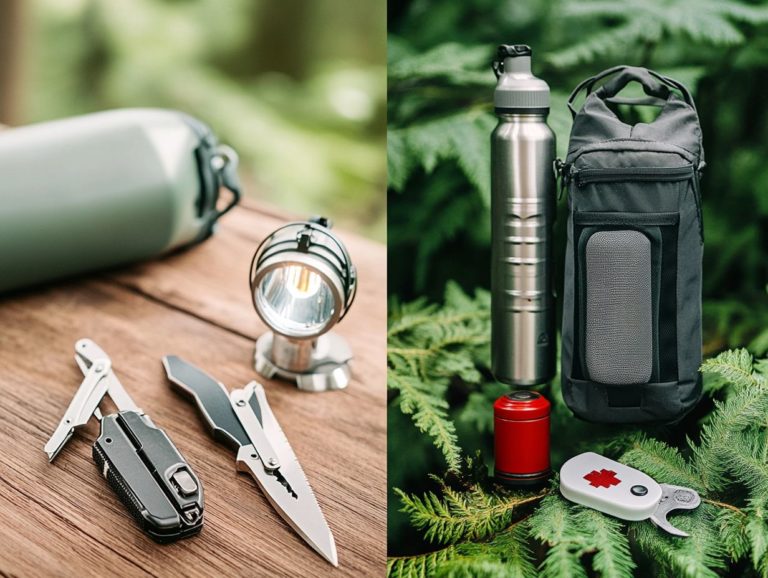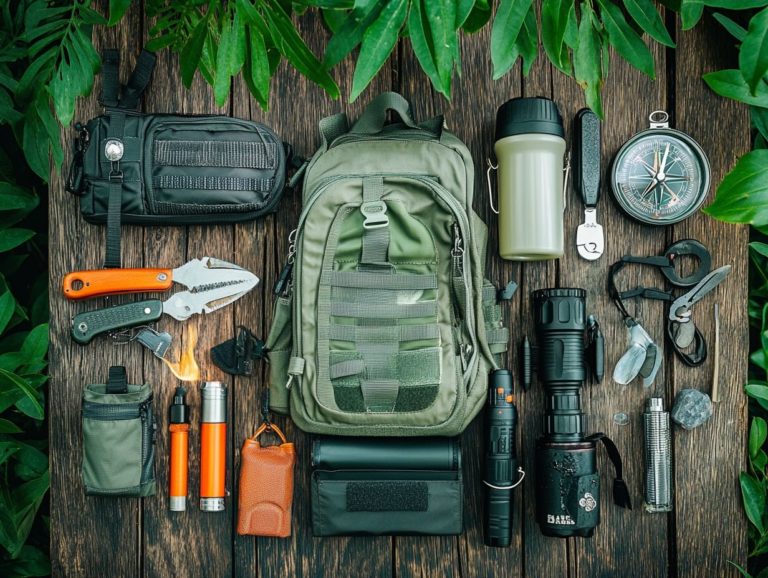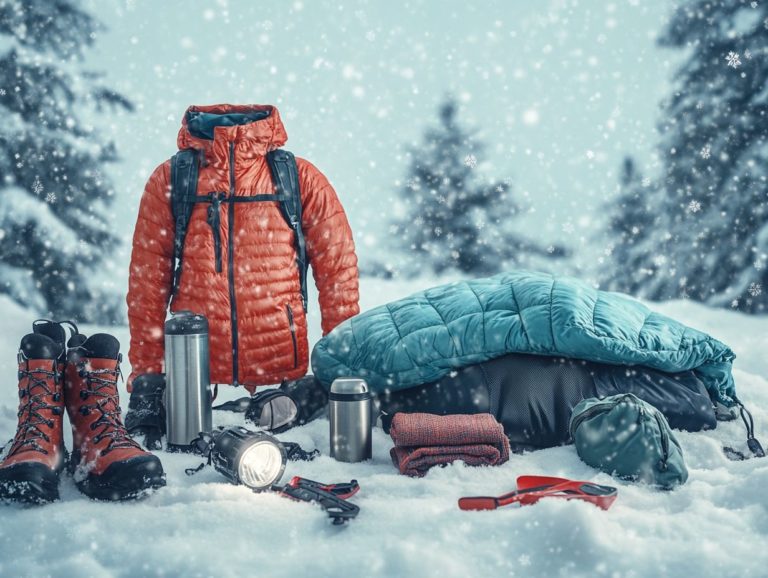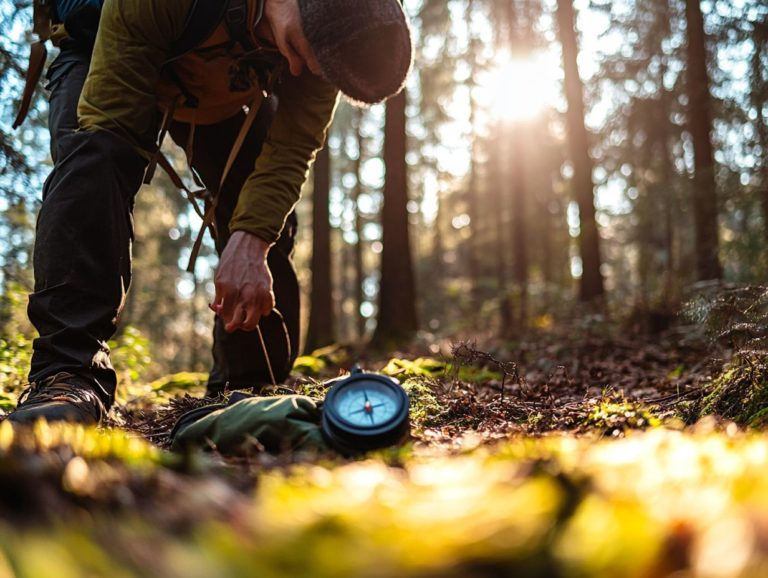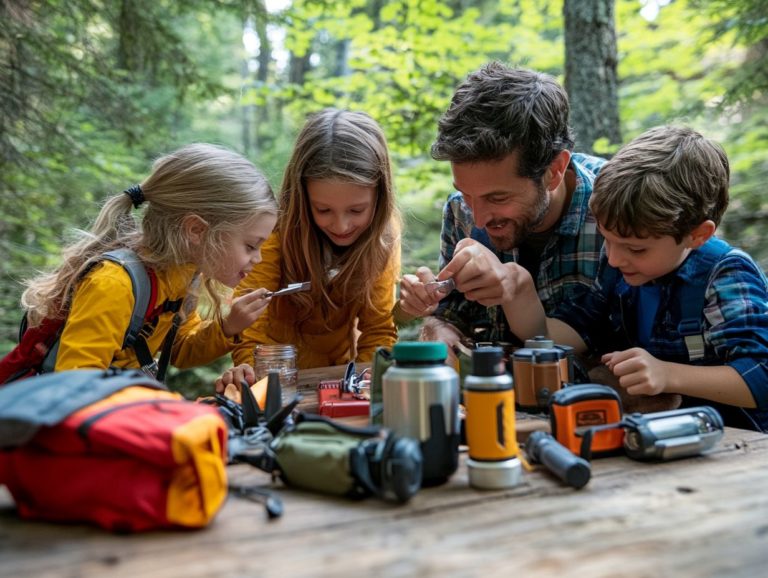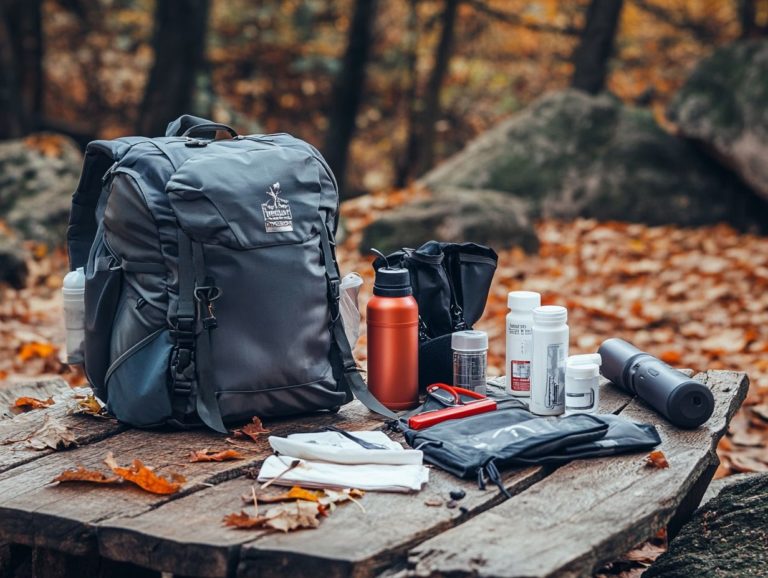Essential Navigation Tools for Survival Gear
When you venture into the great outdoors, having the right navigation tools can make all the difference between a thrilling adventure and a perilous misstep.
From traditional instruments like compasses and maps to modern gadgets such as GPS devices, each tool plays a crucial role in ensuring your safety and success. This article delves into the important navigation tools that deserve a spot in your survival kit, along with insights on how to choose, maintain, and utilize these vital resources effectively.
Whether you re an experienced explorer or just starting out, discovering these tools can elevate your outdoor experiences and keep you safe in unexpected situations. Don’t get caught unprepared!
Contents
- Key Takeaways:
- 1. Compass and Map
- 2. Map
- 3. GPS Device
- 4. Altimeter
- 5. Whistle
- 6. Flashlight
- 7. First Aid Kit
- 8. Water Purification System
- 9. Fire Starter
- 10. Knife
- 11. Emergency Shelter
- 12. Sun Protection
- 13. Emergency Food Supply
- 14. Multi-Tool
- 15. Communication Device
- What Are the Most Important Factors to Consider When Choosing Navigation Tools for Survival Gear?
- Frequently Asked Questions
- What are essential navigation tools for survival gear?
- Why do I need these navigation tools for my survival gear?
- Which type of compass is best for survival gear?
- Can I rely solely on a GPS device for navigation in a survival situation?
- What is the purpose of an altimeter in survival gear navigation?
- Are there any additional navigation tools I should consider for my survival gear?
Key Takeaways:
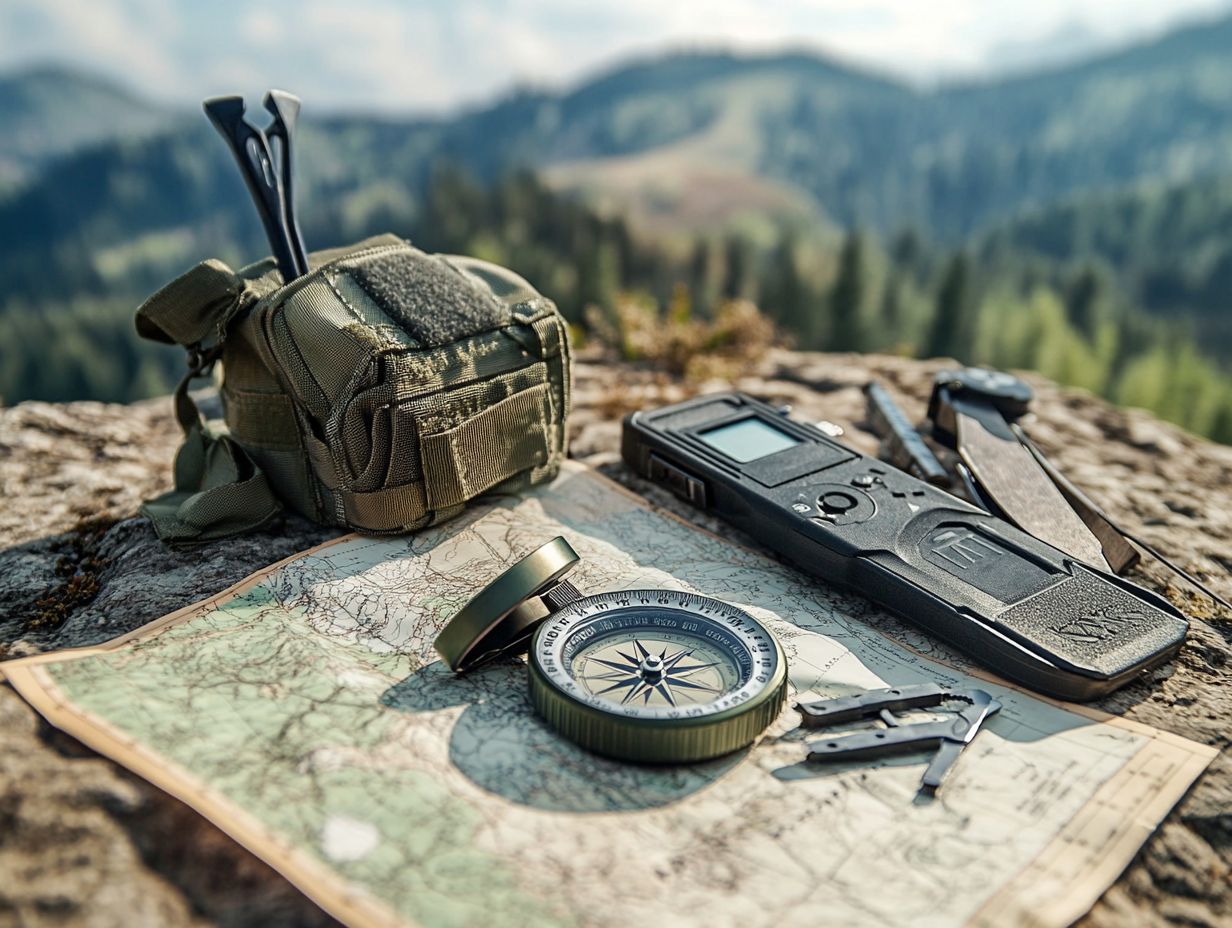
- Carry a compass, map, and GPS device for safe navigation.
- Include emergency gear like a shelter and sun protection.
- Regularly train and maintain your navigation tools for effective use.
1. Compass and Map
A compass is an essential companion in your hiking survival gear, particularly when navigating through wilderness terrains where GPS devices can fail or become unreliable. Mastering the use of this important navigation tool can make all the difference in emergency situations.
Among the various types of compasses available, baseplate compasses and thumb compasses stand out as favorites among adventurers. The baseplate compass, with its clear base for map reading, is perfect for moments when you prefer to have a map in hand. A thumb compass offers a sleek option for quick directional guidance when time is of the essence.
Both types play critical roles in helping you orient yourself in the wild. To maintain pinpoint accuracy, remember to keep your compass away from magnetic fields and calibrate it regularly. In survival scenarios, trusting a compass can lead you safely back to civilization, making it an invaluable asset for anyone daring to explore the great outdoors.
2. Map
A map is an essential element of your hiking survival kit, offering vital information to help you navigate unfamiliar terrain, especially in emergencies when technology may falter.
With a variety of maps at your disposal like topographic maps that show elevation changes and land features or digital maps that provide real-time navigation via GPS grasping their specific advantages is essential for wilderness navigation.
Waterproof maps are especially helpful in the wilderness, ensuring that even during inclement weather, important information stays intact and legible for outdoor enthusiasts.
Mastering the art of reading and interpreting maps can elevate your outdoor experience. Familiarizing yourself with map symbols, scale, and contour lines not only aids in navigation but also deepens your connection with nature.
By combining traditional and modern mapping techniques, including compass and map skills, you can truly enrich your adventures.
3. GPS Device
A GPS device is an essential asset in your hiking survival gear, offering you precise location tracking and navigation capabilities that enhance your outdoor adventures while ensuring your safety in the wilderness.
Whether you opt for a dedicated handheld unit or a smartphone app, these tools are crucial for preventing you from getting lost in unfamiliar terrain. With features like mapping, waypoint marking, and route planning, you can explore remote areas with confidence.
However, it s wise to always carry backup navigation tools, such as a compass and detailed maps, since GPS technology can sometimes stumble due to poor signals or battery issues.
Understanding how to effectively use these devices in survival situations is vital it gives you the power to stay oriented and make informed decisions, ultimately leading to a more enjoyable and safe outdoor experience.
4. Altimeter
An altimeter is an essential tool that provides vital elevation data. It is a crucial component of your hiking survival kit and helps you understand changes in terrain. This enhances your navigation skills during emergency situations.
By measuring altitude, this device is essential in wilderness areas where landmarks might be few. You ll find two primary types: barometric and GPS altimeters, each with unique advantages.
Barometric altimeters measure height by checking air pressure changes and are reliable in stable weather conditions. On the other hand, GPS altimeters use satellite signals to determine your position, which can be especially beneficial in varied environmental conditions.
To make the most of your altimeter, calibrate it at known elevations to ensure accuracy. This simple step enables you to interpret your readings correctly. By taking these precautions, you elevate not only your navigation skills but also your safety in the unpredictable wilderness.
5. Whistle
A whistle is a seemingly simple yet essential piece of hiking survival gear. It can serve as your reliable communication tool in emergencies, allowing you to signal for help without straining your voice.
In challenging situations, this unassuming tool becomes crucial, especially when yelling could lead to fatigue or might simply go unheard in rugged landscapes. You ll find various types of whistles available, from plastic to metal options.
High-decibel whistles are particularly effective, capturing attention even from a distance. Their piercing sound can cut through dense woods or across expansive lakes, making them invaluable when rescue is crucial.
Blow your whistle in short bursts to make sure rescuers hear you! This technique conserves air and helps your signals stand out from natural background noises, increasing the likelihood that rescuers will hear you.
6. Flashlight
A flashlight or headlamp is a must-have in your hiking survival kit. It provides essential illumination during night hikes or emergencies, ensuring you remain safe and visible while navigating those dark, winding trails.
When choosing between the two, factors like brightness levels are crucial. Options range from a modest 100 lumens to an impressive 3000 lumens or even more.
Battery life is another key consideration. Some models may last only a few hours on high settings, while others can shine for weeks at a low setting. It s wise to carry extra batteries to prevent unexpected outages.
Familiarizing yourself with features like adjustable beam focus and strobe settings can significantly enhance your effectiveness in survival situations. Use proper techniques to conserve battery life, such as lowering brightness during longer hikes to greatly extend your operational time.
7. First Aid Kit
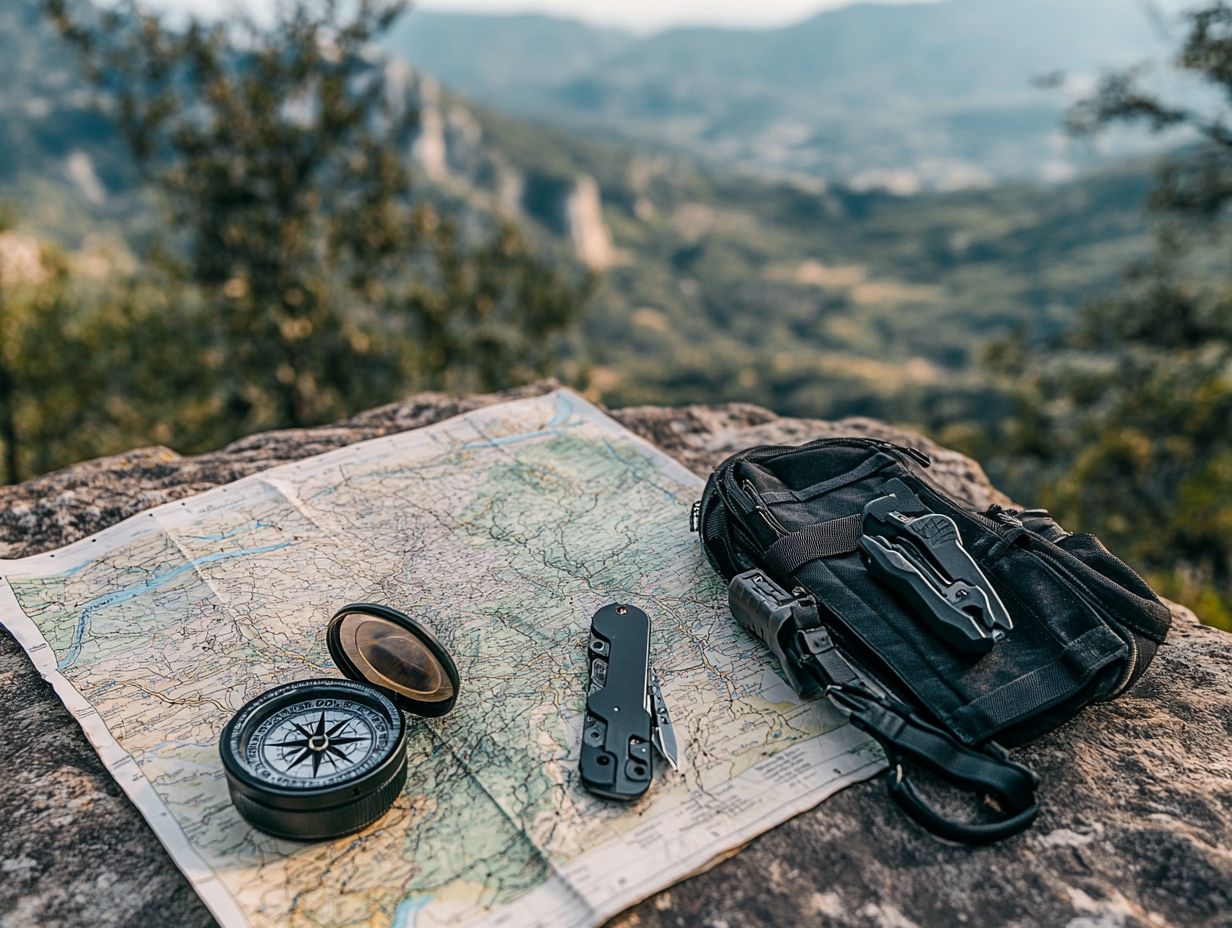
A well-stocked first aid kit is your lifesaver on the trails! It arms you with the necessary emergency medical supplies to handle injuries and medical situations that may crop up during your adventures.
This crucial kit should encompass a variety of items, including survival equipment, high-calorie foods, and more to ensure you are prepared for any situation.
- Bandages in various sizes
- Antiseptic wipes to ward off infection
- Pain relievers to ease discomfort
- Adhesive tape for keeping dressings securely in place
Adding a pair of scissors, tweezers, and gauze can significantly enhance your treatment effectiveness. Understanding how to use these supplies correctly, along with mastering basic first aid techniques, is invaluable in wilderness survival scenarios where timely medical help is often out of reach.
Whether you re dealing with a minor cut, a sprained ankle, or more serious issues, having the right knowledge alongside these supplies fosters confidence and readiness as you explore the great outdoors.
8. Water Purification System
A water purification system, such as the Lifestraw Universal, is essential in your hiking survival gear, ensuring you have access to clean drinkable water, especially in survival situations where contamination could pose a serious risk.
Understanding how to identify and purify water sources in the wilderness is crucial; this skill could very well mean the difference between life and death when faced with challenging environments.
You have various purification methods at your disposal. Filtration systems can effectively remove dirt and pathogens, while chemical treatments, like iodine or chlorine tablets, provide a quick and reliable way to disinfect water.
Boiling water is a classic technique that not only eliminates harmful bacteria but also offers warmth and safety in a survival scenario.
By mastering these methods, you can navigate the wild with confidence, ensuring that you secure the vital necessity of hydration.
9. Fire Starter
A reliable fire starter, such as the berleben Z nden, is very important for your hiking survival kit. It gives you the power to easily ignite fires for warmth, cooking, and signaling during those critical survival moments.
You can find different fire starters to match your needs. Flint and steel offer a classic method, producing sparks that can catch tinder ablaze when struck together. Meanwhile, matches provide a straightforward solution, often conveniently packaged for effortless transport.
Lighters whether disposable or refillable are another favored option, known for being easy to use. It s vital for you to hone your fire-starting techniques, especially when the elements are less than cooperative.
Opting for dry materials, such as inner bark or processed tinder, can greatly enhance your spark transfer technique, ensuring a sustainable flame even in the most challenging conditions.
10. Knife
A quality survival knife is an essential tool in your hiking survival gear, providing the versatility needed for tasks like cutting, carving, and food preparation. It s a must-have addition to your outdoor enthusiast’s multi-tool kit.
Beyond these primary functions, survival knives come in a variety of designs specifically tailored for different activities and environments. For example, fixed-blade knives deliver impressive strength and durability, making them perfect for heavy-duty tasks. On the other hand, folding knives offer portability and convenience, ideal for lightweight packing.
You may also find multi-tools that integrate a knife blade with other handy tools, boosting overall functionality. It’s vital to maintain your knife through regular sharpening and proper cleaning to ensure it performs at its best.
Practicing safe handling, such as keeping the blade covered when not in use and staying aware of your surroundings, can help you prevent accidents during your outdoor adventures.
11. Emergency Shelter
An emergency shelter, such as the TACT Bivvy Emergency Sleeping Bag, is a lifesaver you can’t afford to be without! It offers protection from the elements, allowing you to maintain body heat in critical situations.
These shelters come in various forms, each tailored to meet specific needs and scenarios. For example, the mylar blanket is a lightweight cover that reflects heat back to you, effectively preventing hypothermia. Similarly, bivvy bags are small, waterproof bags that keep you dry and are easy to pack, providing a waterproof layer that shields you from rain and wind essential for those unexpected overnight stays.
Recognizing the importance of these emergency options can significantly enhance your safety and comfort during wilderness adventures, ensuring that even in dire circumstances, warmth and protection are always within your reach.
12. Sun Protection
Proper sun protection is essential for your hiking survival gear. It shields you from harmful UV rays during your adventures and prevents sunburn in critical situations.
Incorporating various forms of sun protection greatly enhances your safety during outdoor activities. Sunscreen serves as your first line of defense. Choose sunscreen that protects against different types of UV rays with an appropriate SPF (Sun Protection Factor) customized for your environment whether you’re soaking up the sun at a beach or tackling a high-altitude hike.
Wearing hats with wide brims helps shield your face and neck from direct sunlight, ensuring maximum coverage. Opt for high-visibility orange clothing, which not only protects against sun exposure but also makes you easier to see outdoors.
By selecting the right products for different conditions, you can fully enjoy your excursions while minimizing the risk of sun-related injuries.
Prepare your sun protection gear today to enjoy your hikes safely!
13. Emergency Food Supply
An emergency food supply, like UST Survival Rations, is crucial for your hiking survival kit. It ensures you have access to high-calorie foods that provide the necessary energy when you find yourself in a survival situation.
You ll discover various types of emergency food supplies, including freeze-dried meals. These meals retain their nutritional value and taste, while also being lightweight and easy to prepare perfect for long treks. High-calorie snacks, such as energy bars and nut mixes, are equally important, delivering quick energy boosts just when you need them.
When packing and storing these supplies, consider using vacuum-sealed bags. This keeps them fresh while minimizing bulk. Remember to store your food in a cool, dry place to extend its shelf life, ensuring everything is ready for your next outdoor adventure.
Stock up on your emergency food supply to be fully prepared for any situation!
14. Multi-Tool

A multi-tool kit is a vital component of your hiking survival gear. It provides a range of functionalities to support you during outdoor adventures and survival situations.
These compact tools typically come equipped with sturdy knife blades for quick cutting, versatile pliers for gripping and manipulating objects, and a variety of screwdrivers for different sizes. Within a single tool, you ll find a can opener, wire cutters, and even specialized attachments for various needs each invaluable in emergencies.
Whether you re faced with a broken tent zipper or a sharp-edged device that needs adjustment, having a reliable multi-tool can transform your ability to navigate unexpected challenges. Its lightweight design ensures it s easy to carry, so you re always prepared for nature’s surprises.
Make sure to carry a multi-tool for your hikes to tackle any issues that arise!
15. Communication Device
A reliable communication device is an essential component of your hiking survival gear. It allows you to call for help or connect with rescue workers in case of an emergency.
With various options available, including satellite phones that work in virtually any location, handheld radios for short-range communication, and personal locator beacons that send distress signals, you have multiple ways to stay connected. Each device serves its unique purpose; for instance, satellite phones provide coverage in remote areas, while radios excel at coordinating your group s efforts.
Always have a backup communication method to stay safe. Relying on just one device can put you in precarious situations if it fails. Being well-prepared can make the difference between an unforgettable adventure and a potential crisis.
Ensure you have a reliable communication device ready for your next hiking trip!
When selecting navigation tools for your survival gear, it s essential to weigh factors like accuracy, ease of use, durability, and compatibility with wilderness survival techniques. These considerations ensure you can effectively navigate through challenging environments.
Among these factors, accuracy stands out as crucial. In dense forests or unfamiliar terrains, a reliable GPS (Global Positioning System) can be the dividing line between safety and disorientation.
Ease of use is equally vital, especially in high-stress situations where every second matters. A complicated device can bog you down, while an intuitive interface allows for quick adjustments and decision-making.
Durability is another key aspect you shouldn t overlook. Your navigation tools need to endure harsh weather conditions. Compatibility with traditional methods like map reading and compass use enhances your survival skills.
In emergency situations, having trusted navigation tools transcends mere convenience it can be a lifesaver, enabling you to find your way back or signal for help when every moment counts.
Additional navigation tools, such as compasses, maps, and GPS devices, can be incredibly beneficial in emergency situations, equipping you with the means to find your way back to safety in challenging terrains.
Integrating tools like altimeters devices that measure how high you are above sea level and smartphone applications can significantly enhance your navigation efforts. An altimeter can be particularly advantageous in mountainous regions where GPS signals may waver.
Smartphone apps that utilize offline maps allow you to access vital information even in remote areas with no service. In tough situations, these tools can be your best friends, guiding you safely back home!
While a compass provides basic directional guidance, the combination of these navigation aids gives you a more comprehensive understanding of your surroundings, giving you the power to navigate treacherous landscapes with confidence.
Mastering the art of navigation is absolutely essential for outdoor enthusiasts like yourself; it elevates your skills you need to survive in the wild and gives you the power to navigate through even the toughest conditions with confidence.
By looking into various navigation techniques such as using a compass, reading topographic maps, and harnessing GPS technology, you can significantly boost your self-assurance in the wild. Aspiring adventurers will find that online courses tailored to navigation can be incredibly beneficial, alongside books that dive deep into the subject. Additionally, exploring the top survival tools for emergency preparedness can further enhance your readiness for any adventure.
Participating in workshops offers you the invaluable opportunity to gain practical, hands-on experience. When you practice navigation in real-world settings, you not only solidify your theoretical knowledge but also prepare yourself to tackle unexpected challenges, transforming yourself into a well-rounded survivalist ready for any adventure that comes your way.
When you’re considering survival gear, seeking out navigation tools from top brands renowned for their reliability and performance is crucial. This ensures you’re fully prepared for any adventure ahead.
Brands like Garmin, Suunto, and National Geographic have established themselves as leaders in this field. Garmin excels with its innovative technology, offering a variety of devices that feature GPS mapping, fitness tracking, and even altimeter readings to accurately measure elevation. Suunto is prized for its rugged design and precision, perfect for those who demand durability in harsh environments.
Meanwhile, National Geographic is celebrated for its comprehensive topographic maps and enriching content, guiding you not just along trails, but through the vast landscapes and cultures you encounter.
Choosing any of these brands means investing in quality, making them essential for anyone looking to elevate their navigation experience in the great outdoors. Explore these brands today to gear up for your next adventure!
To ensure your navigation tools are in top-notch condition, perform regular maintenance. This includes battery checks and adjusting the device for accurate readings, especially before heading out on wilderness adventures.
This proactive approach extends the lifespan of essential devices like GPS units, compasses, and maps. It significantly enhances safety during hikes. Don’t overlook cleaning your gear; it could save your life! This includes removing dust from lenses and making sure all screens are undamaged. For a successful hike, consider using must-have navigation tools for hikers to ensure you stay on track.
When troubleshooting, remember common issues like inaccurate readings or unresponsive interfaces. These can often be resolved by recalibrating the device or replacing low-battery components. Check your gear before each outing to minimize the risk of unexpected surprises while navigating unfamiliar terrain.
Frequently Asked Questions

Essential navigation tools include a compass, map, GPS device, altimeter, and a watch with a built-in compass and GPS.
In a survival situation, knowing your location and being able to navigate to safety is crucial. These tools help you determine your location, plot a course, and keep track of time and distance traveled.
Which type of compass is best for survival gear?
A traditional baseplate compass is often recommended for survival gear. It is lightweight, easy to use, and doesn’t require batteries. However, a digital compass with additional features may also be useful.
No, it is not recommended to rely solely on a GPS device for navigation in a survival situation. GPS devices can malfunction or lose signal, so having backup navigation tools like a compass and map is important.
An altimeter measures altitude and helps determine your location on a map or track your elevation gain or loss. This is especially useful when navigating through mountainous terrain.
In addition to essential tools, helpful navigation tools may include a ruler, protractor, and a whistle for signaling for help. It s also important to have knowledge of basic navigation principles and how to use these tools effectively.
Before your next adventure, give your gear a thorough check!

